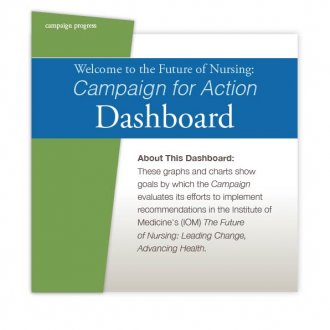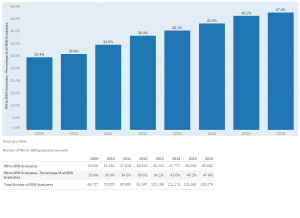Mar 09, 2022
Archived: Dashboard Indicators
In 2024, we condensed and updated the graphs and charts. View new measures.
Developed in 2011, the Campaign for Action Dashboard is a series of graphs and charts the Campaign uses to evaluate its efforts to implement the recommendations in the Institute of Medicine’s The Future of Nursing: Leading Change, Advancing Health report. It contains seven primary indicators: education, doctoral degrees, state practice environment, interprofessional collaboration, leadership, workforce data, and diversity, and can be viewed by clicking the “download” button below. It was updated twice per year and was last updated in September 2021.
Dashboard Secondary Indicators
Below are links to secondary indicator graphics that provide further support for each goal represented within the Dashboard. Data collected was for years 2010-2019.
Indicator 1: Education—Increase the proportion of nurses with a baccalaureate degree to 80 percent by 2020
Number and percent of U.S.-educated, first-time NCLEX-takers with BSN
Number of RN‐to‐BSN graduates annually
Number of hospitals in the United States with Magnet status
Indicator 2: Doctoral Degrees—Double the number of nurses with a doctorate by 2020
Total fall enrollment in nursing doctorate programs
Number of people receiving nursing doctoral degrees annually
Indicator 3: State Practice Environment—Advanced practice registered nurses should be able to practice to the full extent of their education and training
State practice environment for nurse practitioners
State practice environment for certified nurse midwives
NCSBN’s APRN Consensus Model implementation status
Number of nurse-led clinics in the United States
Number of nurse-led clinics located in medically underserved areas (MUA)
Indicator 4: Interprofessional Collaboration—Expand opportunities for nurses to lead and disseminate collaborative improvement efforts
Number of articles published in top 10 health services research journals co-authored by an RN and authors from other disciplines
Indicator 5: Leadership—Health care decision-makers should ensure leadership positions are available to and filled by nurses
Percent of hospital boards with RN members
Indicator 6: Workforce Data—Build infrastructure for collection and analysis of interprofessional health care workforce data
State boards of nursing that participate in the NCSBN Nursys Data System
Indicator 7: Diversity—Make diversity in the nursing workforce a priority
Racial/ethnic composition of the RN workforce in the United States
New RN graduates by degree type, by gender
New RN graduates by degree type, by race/ethnicity
Number of Action Coalitions with members of its’ state’s ethnic or racial minority nursing organization or of its’ men in nursing state chapter as a voting member on its most senior executive-level policy-making body
Diversity of nursing doctorate graduates by race/ethnicity
Diversity of nursing doctorate graduates by gender
States that collect race/ethnicity data about their nursing workforce (by year)
Racial and ethnic composition of RN graduates of pre-licensure nursing education programs and the general population by state – upon request


